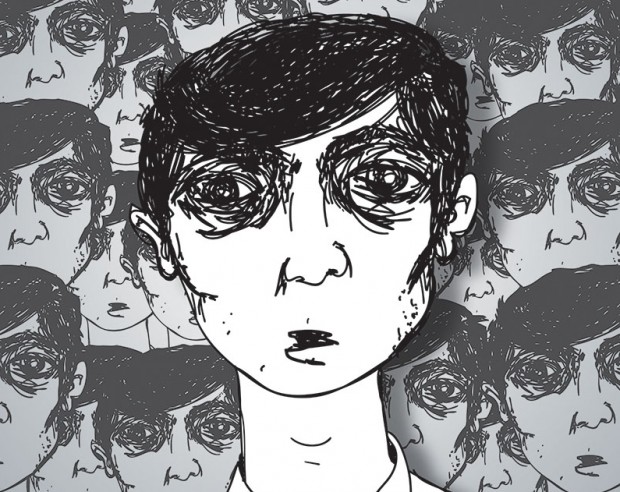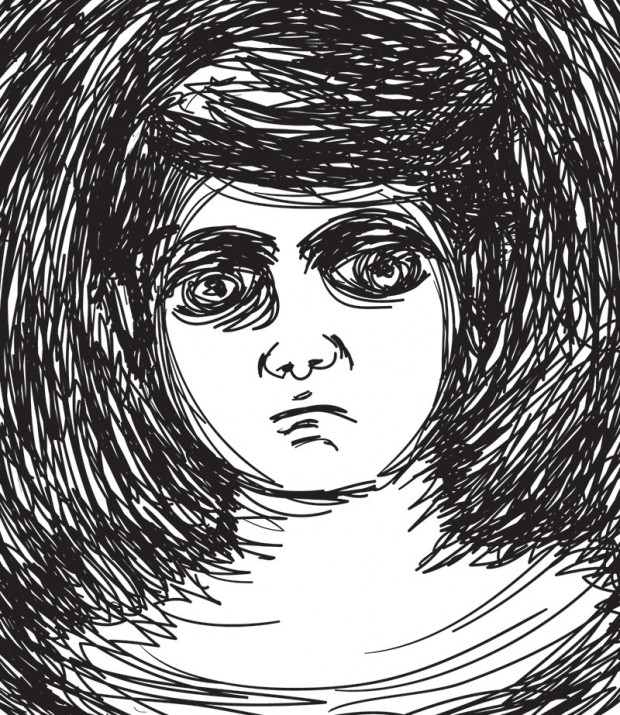Breaking the Chains
How two Buzz residents battled addiction


Addiction takes its toll on mind, body and soul, say counselors who urge families to observe their teen’s behavior for signs of drug or alcohol abuse. (Illustration: istockphoto.com/Jayesh)
It’s 3 a.m., and Memorial High School junior Austin Berry is passed out behind the wheel from a night of drinking, foot on the brake, car in drive.
“Get out of the car,” orders a Hunters Creek policeman.
Austin stumbles from his Jeep Grand Cherokee, which had come to rest in the middle of the road fronting Hunters Creek Elementary, the spot where he slipped into alcohol-induced oblivion.
“You’d think it would be a sobering moment,” says Austin, “but it didn’t really faze me. I was arrested and taken to the Bunker Hill jail till my dad picked me up, really pissed. But hell no, I’m not thinking I have a problem. This is a fluke.”
Austin’s tangled journey of addiction began as a teen and progressed into adulthood, with cocaine and prescription pills the likes of Xanax and the narcotic OxyContin keeping company with booze.
“That was my existence,” says the 28 year old, now sober and a regional marketer for The Last Resort Recovery Center in Smithville, Texas, a 90-day clinical treatment and recovery center for young men.
“Growing up in Memorial, it was just part of the culture,” Austin explains. “Kids don’t have to work; they have plenty of money. It’s easy to get drugs and alcohol. Drugs and alcohol made me feel like I fit in.”
Karen Berry, who had a front-row seat to her son’s nightmare, puts it bluntly. “I think we’re looking at a whole generation that has entitled their kids. We worked hard to get our first cars and put ourselves through college. We wanted to give our kids something better. We did them a huge disservice. We gave them too much.
“I can’t tell you how many funerals I’ve been to, young adults in their 20s,” she says. “I can’t fathom it. My heart breaks for those moms because their kids didn’t make it.”
The epidemic has grabbed communities by the lapels.
Overdose deaths among teens and young adults have skyrocketed during the past decade, more than doubling in ages 12 to 25, according to a report by the U.S. National Institute on Drug Abuse. It’s in large part due to the nation’s epidemic of prescription drug abuse. Ages 18 to 24 are the biggest abusers of prescription opioid pain relievers, ADHD stimulants and anti-anxiety drugs.
“One of the things we’re seeing is a continual abuse of prescription medications like Xanax, Ativan, medications like OxyContin and things along those lines,” says John O’Neill, director of addiction services at Houston’s Menninger Clinic. “What young adults don’t seem to understand is that when you mix those with alcohol, you’re creating a very deadly blend. I can walk into 90 percent of America’s households and find something to get high off of without much problem.”
Austin, a mediocre student, discovered alcohol at 14. Marijuana was added to his “feel good” arsenal at 15. He soon graduated to cocaine. “I was at a friend’s house. I laid down on the bed and felt tingly from toes to chest and thought, ‘Wow! This is what I’ve been looking for.’ All my worries, poof!”
By his senior year he was snorting coke every night. He was kicked off the Memorial High School golf team for not attending practice, but didn’t care. He stole from his parents, skipped school and viewed upcoming college as a giant party. “My parents had rules, but I was sneaky. I was the chameleon and played whatever part I had to play to deceive, connive and get my drugs,” he says.
He was accepted to the University of Alabama with a 2.8 GPA and 1200 SAT, declaring business as his major. His first day a dorm mate introduced him to OxyContin. “He chopped it up, and we snorted it in his dorm room. I felt like Superman.”
Austin was hooked, living only to score pills. When he went without, withdrawal meant sleeping days at a time. Going to class? “Hell no.”
He emerged from the semester pale, several pounds lighter with sunken eyes, lying to his parents about grades. Eventually he was suspended.
“So many things happened after that,” he says. “All bad.” He was arrested for a DWI on his 21st birthday, quickly learning to “game” the probation system. Terms of probation required that he blow into a police-monitored breathalyzer in his car before starting it. He’d drink at night, making sure he waited long enough “so it wouldn’t blow hot,” landing him an automatic 90 days in jail.
He binged on pills, stopping five days in advance of scheduled urine tests so he’d test clean. He hibernated in his apartment, leaving only to meet his drug dealer. “Had him on speed dial.”
Austin vividly recalls his dad’s loving, but hardline ultimatum: “Come live with us and get clean. But if you use again, you’re out on the street. Go join the Navy or something because you’re not coming home.”
Still, Austin rejected the offer until his dad’s caveat, “Okay then, call your mom and tell her you’re never going to see her again.’’
“That did it for me,” Austin says. “I love her so much. I caved.”
Sobriety didn’t come easy, and he relapsed plenty, not fully following the tenets of a 12-step substance-abuse recovery program. But eventually he embraced sober living, climbing out of the abyss. He remembers the day, Sept. 16, 2012, a Sunday.
He had borrowed money from a friend and was on a three-mile jaunt to the dealer, on foot, when he came to a lake. “I thought, ‘Shit, I’ve got to walk around this thing.’ Then boom, it hit me. This was my life. I’m behind on rent, and I’m going to be homeless, and I’m out looking for drugs. For whatever reason, that was my moment of clarity.”
He caught a cab home, attended a 12-step meeting the next day and committed to a life of sobriety. These days he’s engaged to be married and dedicated to helping others beat their addiction demons.
“Life can go sideways on you,” he says. “You can’t do it alone.”

Teens who begin dabbling with drugs often tumble into a hole of full-blown addiction that continues into adulthood. (Illustration: istockphoto.com/Jayesh)
I lived for drugs,” says a former Bellaire High School student, 29, who wishes to remain anonymous. Sober 10 years, he’s now happily married and enjoying his dream job as a sportscaster in a large Texas city.
His memories of teen years into young adulthood are freeze-frames of drug-induced moments, including snorting cocaine for the first time off of his desk in Spanish class. “A kid just offered it to me.”
Intrigued, he purchased coke from a student the next day. “I snorted a pretty big line, put my headphones on, took my dog out and skipped down the street like I’m on top of the mountain.”
He came from a loving, Irish Catholic family. An empathetic kid, he loved animals, his mom and dad. But he also had a rebellious, anti-authority streak and didn’t do well in school.
“I wanted people to think I didn’t care what they thought about me, but I cared deeply. I was the perfect storm for taking weed or alcohol when it was offered to me.”
He began drinking in eighth grade. “The feeling I got from it is what separates me from a normal drinker. It fundamentally changed my perception of the world.”
Recreational fun turned into full-blown addiction with cocaine, Ecstasy, Xanax and all manner of pills making up his drug cachet. He stole money from his parents, skipped class and took drugs every chance he could. A three-day methamphetamine and acid-induced weekend bender with friends is particularly memorable.
“It was weird, like we had a shared hallucination where we were in a river and a hundred dead people were walking toward us,” he recalls.
His parents sent him to a small liberal arts college in a dry county in Arkansas, “thinking that would solve my problem.” Meanwhile, he was loading up on Xanax and meth to enhance his higher learning experience.
His stash didn’t last long, and he started detoxing and sleeping for days, not going to class. He recalls vandalizing a campus flowerbed while drunk and getting caught. “Then college threw me out.”
Nevermind that. Christmas break was here, and he was onto a giant party with Bellaire buddies. He overdosed on the prescription pain drug Fentanyl. A machine breathed for him for four days. Miraculously, he emerged from the hospital stay with no brain damage.
If not for a female acquaintance who left the party to call 911, “I’d be dead,” he says. “All my so-called user friends didn’t want to call police. Too worried about getting in trouble.”
A family intervention led to the Betty Ford Center, where he went through the motions, not really committed to sobriety. He went to another treatment center for young adults where he was introduced to Alcoholic Anonymous 12-step meetings. But he didn’t fully embrace the program and slipped back into old ways.
He remembers the day he was “struck sober.” His girlfriend, now wife, had broken up with him, and he was miserable. He was tired of his lies. Marinating in misery.
“I poured out this gin I was drinking at the time. That was my God-given sobriety date. I was so revolted by myself. Stopped on a dime.”
These days he’s in love with sober living and helps others beat their insatiable dependence on drugs and alcohol. “I feel so fortunate that I received God’s gift, the desperation to quit,” he says. “That was my saving grace.”
Warning signs and what to do
Addiction. Male, female, young or old, its face is the same. It divides, ruthlessly excising friends and family. Those in its grip abandon morals when it comes to obtaining drugs or alcohol, whatever the substance of choice. It’s all about how to get it, where to get it. And when can I do it again?
“When it comes to substance abuse, if parents suspect it, I would encourage them to have a direct conversation with the child to start things off,” says John O’Neill, director of addiction services at Houston’s Menninger Clinic. “Sit down and talk to them openly. You may be surprised that some kids might tell their parents what’s going on. Some lie. It’s a mixed bag.”
Pay attention to certain signs that could indicate a drug or alcohol addiction, he says.
Your child doesn’t make eye contact.
Their behavior radically changes; an overall sense of moodiness.
They don’t want to introduce you to their friends.
Grades are slipping.
They lose interest in hobbies and things they once enjoyed.
They start withdrawing.
They become angry easily, sneaky and dishonest.
There’s a disruption in their sleep and eating patterns.
They seem to hang onto certain items, such as a backpack.
At the same time, be aware of your home environment. Are you reducing access to alcohol? If there are prescription drugs in the house, make sure they are under lock and key and not accessible. “Not just for your kids, but for your kid’s guests,” O’Neill advises. “If you get to the point where you have questions and aren’t sure what’s going on, it’s time to reach out to a professional. There are a lot of wonderful professionals in the community who can help.”
Providing an alternative peer group for teens is absolutely crucial, says Joe Parker, a licensed clinical dependency counselor in Bellaire. He sees addicted teens and young adults through his private practice and alliance with the Houston-area Cornerstone Recovery, a charitable organization that raises funds for its Outreach and Adventure Learning Program.
The program provides a fun, sober environment for teens where they can build healthy relationships and self-esteem. It also teaches parents how to drive their teen’s recovery and take back control.
“Two key components create magic for people in recovery,” Parker says. “One of them is a positive peer group. You’ve got to have real friends who actually see you and love you and encourage you to grow in your recovery, to work your 12-steps, embrace the principles and who won’t put up with your BS. They push you to be better. That means more than anything mom or dad or a counselor or teacher has to say for sure.
“The other element is family support,” he continues. “It’s one of the things we work hard to implement with our families because addiction isn’t just an individual disease. It’s a family disease. We help the family to work the 12-steps too.”
Parker stresses how important it is to watch your child’s behavior. “That tells you everything you need to know,” he says, cautioning parents to not stick their head in the sand. “Denial is a very real thing, and it can be difficult for parents to deal with it. I see parents almost daily breaking through that.”
Want more buzz like this? Sign up for our Morning Buzz emails.
To leave a comment, please log in or create an account with The Buzz Magazines, Disqus, Facebook, or Twitter. Or you may post as a guest.


